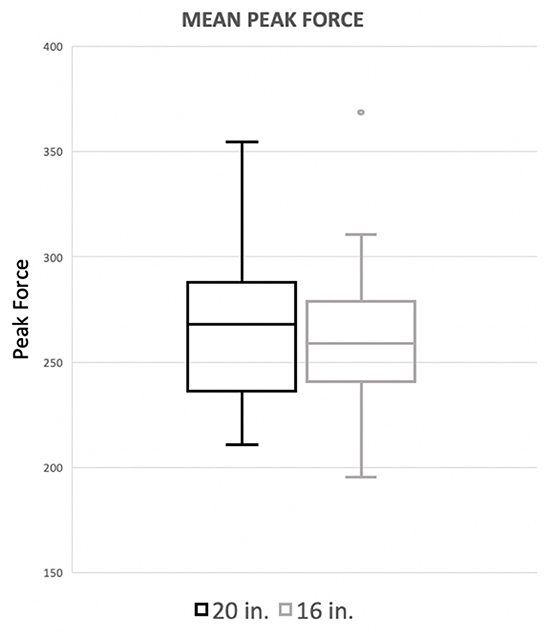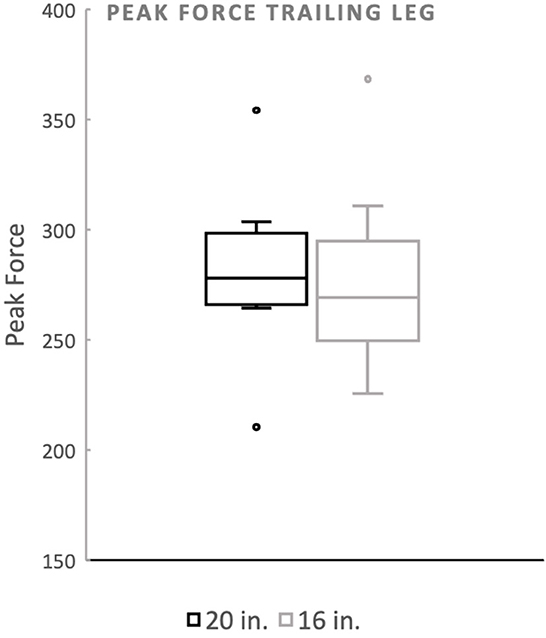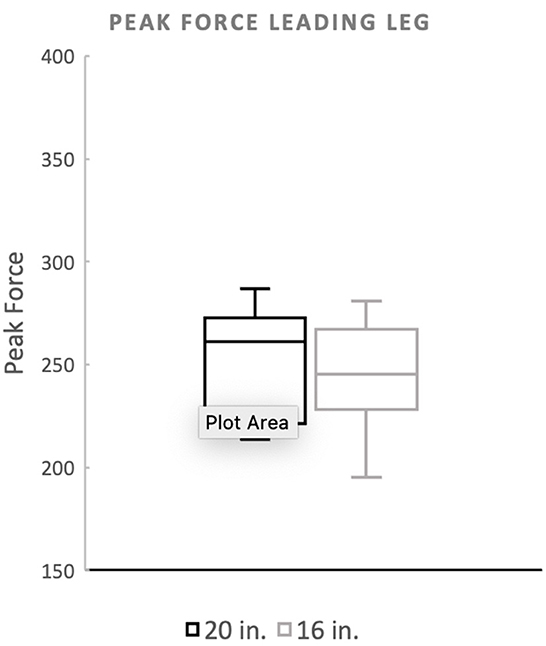Effects of jump height on forelimb landing forces in border collies
- 1Department of Veterinary Clinical Sciences, The Ohio State University, Columbus, OH, United States
- 2Zink Integrative Sports Medicine, Ellicott City, MD, United States
A corrigendum on
Effects of jump height on forelimb landing forces in border collies
by Pogue, J., Zink, C., and Kieves, N. R. (2022). Front. Vet. Sci. 9:1006990. doi: 10.3389/fvets.2022.1006990
In the published article, there was an error in Figures 2–4 as published. Peak force values were off by a decimal point. The corrected Figures 2–4 and their captions appear below.

Figure 2. Mean peak force when averaging the forelimbs. There was no significant difference between the standard (20′′) or preferred (16′′) height for mean peak force of the forelimbs.

Figure 3. Peak force of the trailing forelimb. There was no significant difference between the standard (20′′) or preferred (16′′) height for the trailing forelimb. The dots noted outside the box plot are outliers.

Figure 4. Peak force of the leading forelimb. There was no significant difference between the standard (20′′) or preferred (16′′) height for the leading forelimb.
In the published article, there was an error. Values for peak force were off by a decimal point.
26.5 should have read 266.4; 26.09 should have read 260.9; 28.29 should have read 282.9; 27.81 should have read 278.1; 24.83 should have read 248.3; and 24.11 should have read 241.1.
A correction has been made to Results, paragraph 2. The sentences previously stated:
Mean peak force when averaging the forelimbs was 26.5 (%BW) for the 20′′ jump height and 26.09 (%BW) for the preferred jump height (Figure 2). The means of these two groups was not statistically significant (p = 0.4228). When evaluating the peak force of the trailing forelimb, the mean peak force was 28.29 (%BW) for the 20′′ jump height and 27.81 (%BW) for the preferred jump height (Figure 3). The means of these two groups was not statistically significant (p = 0.7081). When evaluating the peak force of the leading forelimb, the mean peak force was 24.83 (%BW) for the 20′′ jump height and 24.11 (%BW) for the preferred jump height (Figure 4).
The corrected sentence appears below:
Mean peak force when averaging the forelimbs was 266.4 (%BW) for the 20′′ jump height and 260.9 (%BW) for the preferred jump height (Figure 2). The means of these two groups was not statistically significant (p = 0.4228). When evaluating the peak force of the trailing forelimb, the mean peak force was 282.9 (%BW) for the 20′′ jump height and 278.1 (%BW) for the preferred jump height (Figure 3). The means of these two groups was not statistically significant (p = 0.7081). When evaluating the peak force of the leading forelimb, the mean peak force was 248.3 (%BW) for the 20′′ jump height and 241.1 (%BW) for the preferred jump height (Figure 4).
The authors apologize for this error and state that this does not change the scientific conclusions of the article in any way. The original article has been updated.
Publisher's note
All claims expressed in this article are solely those of the authors and do not necessarily represent those of their affiliated organizations, or those of the publisher, the editors and the reviewers. Any product that may be evaluated in this article, or claim that may be made by its manufacturer, is not guaranteed or endorsed by the publisher.
Keywords: agility, jump height, bar jump, landing force, peak force, peak contact pressure
Citation: Pogue J, Zink C and Kieves NR (2023) Corrigendum: Effects of jump height on forelimb landing forces in border collies. Front. Vet. Sci. 10:1233874. doi: 10.3389/fvets.2023.1233874
Received: 02 June 2023; Accepted: 09 August 2023;
Published: 25 August 2023.
Edited and reviewed by: David Levine, University of Tennessee at Chattanooga, United States
Copyright © 2023 Pogue, Zink and Kieves. This is an open-access article distributed under the terms of the Creative Commons Attribution License (CC BY). The use, distribution or reproduction in other forums is permitted, provided the original author(s) and the copyright owner(s) are credited and that the original publication in this journal is cited, in accordance with accepted academic practice. No use, distribution or reproduction is permitted which does not comply with these terms.
*Correspondence: Nina R. Kieves, a2lldmVzLjFAb3N1LmVkdQ==
 Joanna Pogue
Joanna Pogue Chris Zink
Chris Zink Nina R. Kieves
Nina R. Kieves